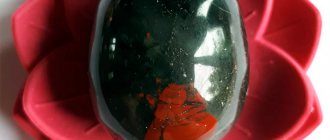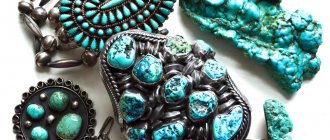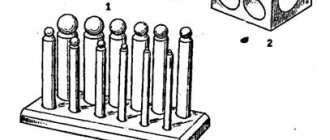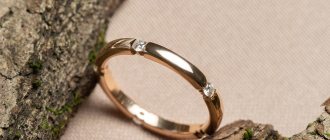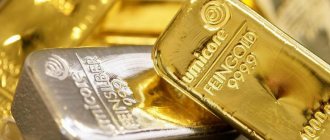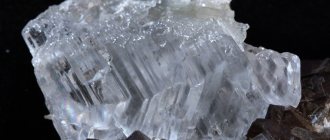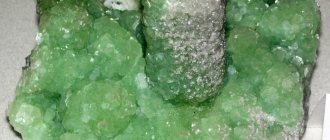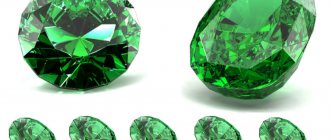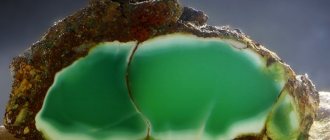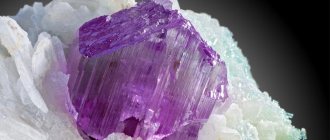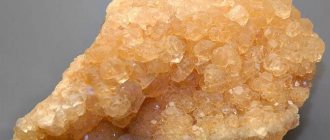| Category | Silicate minerals |
| Title in English | Axinite-(Fe) |
| Formula | Ca2Fe2+Al2[BSi4O14](OH) |
| Group | Aksinit Group |
| Color | Brown, Gray |
| Stroke color | White |
| Shine | Glass |
| Transparency | Transparent, Translucent |
| singonia | Triclinic |
| Hardness | 6,5 — 7 |
| Cleavage | Imperfect (not observed) |
| Density, g/cm³ | 2.25 - 2.28 g/cm³ |
| Kink | Conchoidal |
| origin of name | The name axinite comes from the Greek word for ax - axine. It was not given by chance, but because of the shape of the stone crystals. They come with a sharp cut at the end and give off a characteristic metallic sheen. |
| Morphology | The compacted crystals have sharp, axe-shaped heads. The stone itself is grainy and massive. |
- 6.1 Medicinal properties
History and origin
The mineral was discovered in 1797 by the French mineralogist Rene Juste Gaoui, but it has not been known to mankind for the first millennium.
Exhibit – Aksinita
Due to its shape and hardness, axinite was used as a tool. In addition, the mineral was widely used in various rituals. For example, the priestesses of Artemis used a gray stone, Hecate - purple, Selene - yellow.
Classification
Axinite is understood as a group of stones of the same structure, but with a different dominant mineral:
- Magnesioaxinite. Magnesium dominates. Colors range from soft blue to gray.
- Ferroaxinite. "Iron". Brownish-brown with violet, black.
- Manganaxinitis. Manganese creates a yellow-orange color scheme.
- Tinzenite. Iron plus manganese, shades of yellow, orange to red.
The 4th variety is named after its location in the Swiss Alps.
Place of Birth
Deposits of axinite are found in France, the USA, Mexico, Tasmania, Brazil, Tajikistan, Switzerland, Poland, Norway, Finland, and the rarest type, a blue mineral, is mined in Tanzania. In Russia, axinite deposits are located in Chukotka and the Urals.
In nature, axinite occurs in both single formations and multiple clusters. The mineral is formed in skarns and is found in pneumatolytic, hydrothermal and metamorphic complexes.
Associated minerals with axinite are quartz, chlorite, feldspar, epidote, magnetite and sulfides.
Stone sizes
Translucent Axinite weighing more than 5 carats are exhibits for museum exhibitions. Faceted specimens over 10 carats are rare. The minerals from the deposit in Baja California weigh 25 carats, but when refined, these stones will weigh less than 5 carats.
- Axinite 23.6 ct: Found in Mexico, housed in the Smithsonian Institution Museum in Washington, DC.
- Axinite 16.5 carat: found in Baja California (Mexico), kept in a private collection
- Magnesio-axinite 0.78 carats was found in Tanzania, stored in the Geological Museum of London (Natural History Museum, London).
Physico-chemical properties of stone
| Property | Description |
| Formula | (Ca,Fe,Mn)3Al2BO3Si4O12OH or Ca2(Fe,Mn)Al2BSi4O15(OH) |
| Hardness | 6,5 — 7 |
| Refractive index | 1,675 — 1,685 |
| Selection form | Tabular, lamellar or lance-shaped crystals |
| Kink | Uneven, conchoidal |
| singonia | Triclinic |
| Cleavage | Perfect |
| Shine | Glass |
| Transparency | Translucent or transparent |
| Color | Brown, violet-brown, bluish-violet |
Price
Axinite is offered sparingly on sale: you can buy collectible material and inserts for jewelry.
The stone is not considered precious, but rarity increases the price (thousand rubles):
- inserts (up to 1 carat) – 4 – 6.5;
- stone (cut; 2.5 carats) – 9.9;
- collection sample (27x51x17 mm; Peru) – 2.4.
Jewelry is available to order. For example, a gold ring with axinite from Afghanistan (1.3 carats) will cost 16-20 thousand rubles. The same in silver - 9-12.5.
Faceted axinite
The world price of axinite is $10-50 per carat. The exact number is determined by the unusual shape, transparency, dimensions of the crystal, and the skill of the cutter.
Varieties and colors
Axinite is a wedge-shaped stone, slightly beveled and flattened, with sharp edges and oblique edges covered with streaks. The color range of the mineral includes specimens of brown, purple, gray, green, blue and red shades.
Axinite includes several varieties:
- Magnesioaxinite is a blue, pale violet or light gray mineral with an admixture of magnesium. It has a glassy luster and translucent structure. In sunlight it changes color to pale red. Found in Tanzania, Australia and the USA (Nevada, California);
- Tinzenite is a yellow, orange or red mineral with black features. It can be either matte or glassy. Opaque or slightly translucent. Deposits – Switzerland, Italy, Russia (Kozhaevskoye deposit, Southern Urals);
Tinzenite - Ferroaxinite is a mineral of violet-blue, greenish-yellow, brown or gray color, with white features, and contains an admixture of iron. Has a glassy sheen and light/full transparency. Quite fragile, it is rarely used in jewelry. Found in Great Britain, Austria, Poland, Czech Republic, Slovakia, New Zealand, Namibia, Iran, USA, Russia;
Ferroaxinite - Manganaxinite (severgenite) is a pale lilac, yellow, brown, red, or colorless mineral with white features, containing manganese. It has a glass luster and can be either transparent, translucent, or opaque. In the sun it changes color to lilac-red. Deposits - Peru, Morocco, Madagascar, Australia, New Zealand, Japan, USA.
Manganaxinitis
Reference! An interesting property of the mineral is the so-called pleochroism effect, or the ability of a stone to change shades under different angles and lighting. For example, if you look at axinite in the sun, it will look paler than in darker lighting.
What is a stone
The international name of the stone comes from the ancient Greek ἀξίνη - “axe”.
The mineral axinite is noteworthy:
- The shape of the crystals really looks like a wedge. They have oblique edges with strokes, sharp edges, and slight flattening.
- Various degrees of transparency, glass luster.
- Common colors are brown, greenish, gray, purple, and combinations thereof. Red, white, pink, blue specimens are rare.
- Endowed with pleochroism. Green, reddish-brown, yellow-brown shades change depending on the lighting and viewing angle.
Axinite also appears in the literature as severingite and tumite.
Magic properties
Axinite has been credited with magical properties since ancient times. For example, in Tasmania, local residents believe that the mineral is closely connected with the Moon; it is even called “tears of the Moon.” They believe that the stone is able to cleanse the soul of negativity and worries and protect it from the effects of negative energy, which is why amulets and amulets with axinite are often worn by mothers and children.
Also, axinite gives its owner energy, increases fortitude and helps smooth out conflict and resentment after it.
But in China, it is believed that axinite normalizes the balance of Yin and Yang energies in a person’s home, so it is used to make household items and talismans.
It is recommended to keep axinite in every home, especially where newlyweds live or there are children. And jewelry with axinite will be a good gift for a wedding, birth of a child, housewarming, or just a birthday.
Scope and scope
Considering the fairly large number of axinite deposits, it still remains a rare stone. Cut samples are usually no more than five carats. This is due to the fact that the crystals of the mineral are asymmetrical. Their unusual, amazing shape much more often attracts the attention of collectors rather than jewelry makers. In jewelry, axinite is used only in conjunction with a protective frame, for example, in necklaces, earrings, pendants, pins, and brooches. The variety of colors and comparative availability still ensure the use of the mineral in jewelry.
Medicinal properties
Axinite is considered a “female” stone, therefore its healing properties are aimed at treating specifically female diseases. A brooch with axinite prevents the development of mastopathy. The stone can increase lactation; axinite is recommended to be worn during breastfeeding. A ring with axinite on the left hand, on the ring finger, can relieve frigidity and help in the treatment of infertility. In addition, earrings with this mineral eliminate headaches and have a calming and emotional stabilizing effect.
Magic properties
When in ancient times young girls were initiated into priestesses of the Moon, they used axinite. Three lunar deities were distinguished: Artemis - the goddess of the waxing Moon, Selene - the mistress of the full moon, Hecate - the mistress of the waning luminary, and, accordingly, three shades of the mineral. Pearl-gray axinite served Artemis, honey-yellow served Selene, and rich violet served Hecate. Axinite “connected” the priestess girl with the deity, and served to convey orders, advice and warnings to her. The Chinese consider axinite to be an accumulator of Yin energy, and they make various products from it to neutralize aggressive Yang energy and create harmony in the home.
Suitable for zodiac sign
The axinite stone is suitable for most zodiac signs, except for representatives of the fire element, that is, the gem is not recommended for Aries, Leo and Sagittarius. Axinite is favorable for Scorpios and Geminis.
Caring for your jewelry
Although the stone is hard, and it is impossible to accidentally break it, jewelry with it still requires careful care.
Axinite has the ability to become electrified, so dust can quickly settle on it during storage. To carefully clean the stone from dirt, you need to wipe it with a piece of soft cloth lightly dampened in warm soapy water, and then rinse with clean water.
It is better to store the stone and jewelry with it in closed boxes, away from exposure to high temperatures.
How to identify a fake
Glass is often offered under the guise of axinite.
You can distinguish it in several ways:
- Hold it in your hands. The glass will heat up almost immediately.
- Consider the structure . Absolutely clean copies are not sold in stores. Standard axinite contains inclusions, turbidity, and other “flaws.” But air bubbles are not a sign of glass.
Brown-gray axinite looks like rauchtopaz and is easy to confuse. However, axinites are not large and lack smoke.
There are no artificial specimens: the structure is too complex.
Compatibility with zodiac signs
(“+++” – the stone fits perfectly, “+” – can be worn, “-” – is strictly contraindicated):
| Zodiac sign | Compatibility |
| Aries | — |
| Taurus | + |
| Twins | +++ |
| Cancer | + |
| a lion | — |
| Virgo | + |
| Scales | + |
| Scorpion | +++ |
| Sagittarius | — |
| Capricorn | + |
| Aquarius | + |
| Fish | + |
Axinite is suitable for almost all zodiac signs, with the exception of representatives of the fire elements - Sagittarius, Leo and Aries. The stone is especially revealed to Gemini and Scorpio.
Is this stone right for you?
Chemical composition
Chemical theoretical composition of the extreme ferrous member of the series - ferroaxinite: CaO - 19.65, FeO - 12.64, Al2O3 - 17.90, B2O3 - 6.11, SiO2 - 42.12, H2O - 1.58; manganaxinite: CaO—19.70, MnO—12.48, Al2O3—17.93, B2O3—6.11, SiO2—42.20, H2O—1.58.
The Fe2+ - Mn2+ isomorphism causes compositional variations from ferruginous axinite to iron-free manganaxinite. The distribution of the compositions of minerals in this series on the triangular diagram CaO—MnO (Fe, Mg)O indicates a relatively constant calcium content. The lowest MnO content (0.28%) was determined in dark lilac axinite from Kazakhstan. The most ferruginous axinite with FeO = 11.00% and MnO = 1.03% was described by Yusupova et al. from the calc-ferruginous skarns of Southern Gissar in Tajikistan. Less ferruginous axinites are more common. Manganaxinites are those that contain 6-12% MnO. The most enriched in manganese include manganaxinites from Mesabi (USA) (11.66% MnO), Radautal, Bavaria (11.54% MnO) and from skarn-borosilicate formations of the Far East (9.98% MnO). Fe2+ can be isomorphically replaced by Mg. The MgO content rarely exceeds 1%; it was still considered to be the highest in axinite from the Seelbach diabases (Westphalia)—4.13% and in axinite from the epidote-amphibolite hornfels of New South Wales (Australia)—4.2%; the composition of the latter's cations is Ca2O4 (Mg0.59Feo.4Mn0.11).
In 1975, Jobins et al. in Tanzania encountered axinite in which all Fe2+ was replaced by Mg (MgO content - 6.9%), which allowed them to isolate magnesioaxinite as an independent member of the axinite group. In Axinite from Franklin, PC. New Jersey (USA) noted ZnO content up to 2.20%. Spectroscopically, V, Cu, Sn Pb, Cr, Zn, Ag, Be, La, Sr, Au, As were found in axinites.
Crystallographic characteristics
system C1i - P1.
Class. Pinacoidal—1.
Crystal structure
Main forms : b (010), r (011), M (110), l (120), s (121), x (111), a (100), y (101).
The structure was originally determined by Ito and Tekeuchi in 1952 for axinite from Obira (Japan) with the ratio Fe : Mn = 7 : 3. According to their data, the structure is based on island quadruple rings of SiO4 tetrahedra and BO3 orthotriangles. However, based on the study of IR absorption spectra, even before the structure of axinite was refined, the presence of boron-oxygen tetrahedra, rather than triangular BO3 groups, was proven in it. The refinement of the structure of axinite carried out in 1969 by Ito et al. on a sample from Uuhake (California) with a Fe:Mn ratio close to 1, confirmed the data of IR spectroscopy and made it possible to interpret the structure of axinite in a different way. In the new version, the structure is based on centrosymmetric island groups [B2Si8O30], composed of two diortho groups [Si2O7], connected to each other into six-membered rings by two single BO4 tetrahedra. One more diortho group [Si2O7] is attached to the outer O of two BO4 tetrahedra. The rings are nearly parallel to the s(121) faces, one of the common crystal shapes of axinite.
Borosilicate radicals [B2Si8O30] form double-sided networks divided into island groups. Between such networks there are layers of AlO5(OH)-, (Fe, Mn)O6- and CaO5(OH)-octahedra.
Peculiarities
The shape of the specimens often resembles an axe: sharp and wedge-shaped, which is why such a symbolic name was given. Axinite, from the word ax - “axe”.
You can often find druses of transparent crystals. A slightly chaotic, oblique arrangement gives sharpness to the edges.
Quite unusually, the stone has the effect of pleochroism. That is, an optical property that allows you to change colors and shades under different lighting and viewing angles. So, in sunlight the gem looks somewhat paler.
The right choice of jewelry with axinite
The stone is rarely used in the jewelry scene. Due to its structure, it is difficult to produce jewelry higher than 5 carats, and the cut is always faceted, with the shape of a pear, oval or circle.
- The brooch will be a unique addition to the overall look. It is advised to choose it in the form of a flower or an animal. But axinite in a beautiful frame and with ornaments is more highly valued.
- Neck jewelry, be it pendants or pendants, is considered not just a decoration, but a talisman charged with positive energy. Therefore, they can be considered as a gift.
Jewelry is chosen based on its healing properties or esoteric advice. Therefore, the main products are earrings, rings and brooches.
Although this mineral is not so popular on the market, its extraction is not so simple. Due to these factors, the average price of jewelry ranges from 10 to 50 dollars per 1 carat.
But it is worth noting that the stone has an unusual structure, which means there is a demand for purchasing non-standard lots. In such cases, the price can increase up to $100 per carat.
Form of being in nature
The appearance of crystals . Crystals of different shapes, mostly tabular to one degree or another along the faces r, b, M, etc., often wedge-shaped and spear-shaped with sharp edges, also columnar along the b axis (less often along the c axis), isometric. Subparallel and fan-shaped groupings of crystals from Japan, sheaf-shaped and comb-shaped forms with curved edges were noted in split crystals from the Subpolar Urals. Vertical hatching on the r (011) and M (110) faces is characteristic; On the r (011) faces, hatching parallel to the [010] : [011] edge is common. On the habit forms b, M, r and x there are growth figures - vicinals of different shapes. The shapes of the etching figures (with different reagents) are characteristic of each of the habit forms.
The distribution and shape of the growth and dissolution figures confirm the triclinic-pinacoidal class of symmetry.
Doubles. In axinite crystals from the Altai Mountains, HF etching revealed growth zoning and a twinning structure. Lodochnikov discovered under a microscope in an axinite crystal twins along (100) with a twin axis [023] (in a Peacock installation).
Aggregates. Crystals are tabular and wedge-shaped from fractions of a millimeter to 2-3 cm, sometimes larger, form drusen in cracks and voids; Granular and shell-like aggregates, as well as solid masses, are common.
Crystal optical properties in thin preparations (sections)
In thin sections in transmitted light it is colorless or slightly colored. Pleochroism is distinct only in thick sections: for Ng it is light yellow or colorless, for Nm it is violet, and for Np it is light brown. Nm>Np>Ng.
Biaxial (—). Np and the plane of the optical axes is almost perpendicular to (111). The orientation of the optical indicatrix varies somewhat among different axinites.
The refractive indices of axinites of the ferroaxinite-manganaxinite series slightly increase with increasing manganese content; their values range from: ng = 1.668–1.699, nm = 1.665–1.698, np = 1.659–1.690, ng-np = 0.009–0.011; 2V = 63-76° (in some cases 82, 87 and even 90°). Dispersion is strong, r
Axinite with quartz Biryusa River
